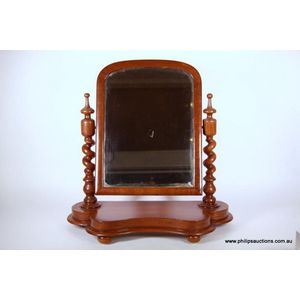Victorian Sterling Silver Presentation Tray
You must be a subscriber, and be logged in to view price and dealer details.
Subscribe Now to view actual auction price for this item
When you subscribe, you have the option of setting the currency in which to display prices to $Au, $US, $NZ or Stg.
- Sterling Silver - Sterling silver is a mixture of 92.5% pure silver and 7.5% of another metal, usually copper. Fine silver is 99.9% pure silver, and is relatively soft and the addition of the very small amount of copper gives the metal enough strength and hardness to be worked into jewellery, decorative and household objects.
- Hallmarks - A mark stamped on articles of precious metals in Britain, since the 14th century, certifying their purity. It derives its name from the Guild Hall of the Goldsmiths' Company, who recieved its Charter in 1327 giving it the power to assay (test the purity) and mark articles of gold and silver.
The hallmark will consist of several marks, including the:
- silver standard mark, indicating the purity of the metal. Sterling silver is .925 pure silver.
- the city mark indicating the city in which it was assayed eg London, Birmingham, York etc.
- the date mark, usually a letter of the alphabet in a particular font and case,
- a duty mark, indicating whether duty had been paid to the crown, and only in use from 1784 to 1890
The piece may include an additional mark, the maker's mark, although not forming part of the hallmark, will be located in the vicinity of the hallmarks.
Sometimes silver plated items will bear faux hallmarks, often confusing those not familiar with silver markings. - Bright Cut Decoration - Bright cut decoration is a technique used to decorate silver and other metal objects, such as jewellery and flatware, with intricate and detailed patterns. The technique involves using a small, sharp tool called a graver to carve designs into the surface of the metal. These designs are then polished, creating a bright, reflective surface that contrasts with the surrounding metal. The designs can be simple or complex, and can include geometric shapes, scrolling vines, and other decorative elements. The technique is highly skilled and requires a lot of precision, patience and attention to detail.
Bright cut decoration was widely used in the 18th and 19th centuries, particularly in the silverware and jewellery industries. It was popular in the United States, Great Britain and Europe.
Today, bright cut decoration is still used by some craftsmen and artists, but it is considered a traditional technique and is not as widely used as it was in the past. However, the bright cut decoration on a silver object is still considered a sign of quality and craftsmanship and is highly prized by collectors of antique silver and other metal objects. - Victorian Period - The Victorian period of furniture and decorative arts design covers the reign of Queen Victoria from 1837 to 1901. There was not one dominant style of furniture in the Victorian period. Designers used and modified many historical styles such as Gothic, Tudor, Elizabethan, English Rococo, Neoclassical and others, although use of some styles, such as English Rococo and Gothic tended to dominate the furniture manufacture of the period.
The Victorian period was preceded by the Regency and William IV periods, and followed by the Edwardian period, named for Edward VII (1841 ? 1910) who was King of the United Kingdom and the British Dominions and Emperor of India for the brief period from 1901 until his death in 1910.
This item has been included into following indexes:
Visually similar items

A Victorian mahogany barley twist shaving mirror, second half 19th century, the gently arched mirror in a simple unadorned frame set within barley twist side supports with finials to a shaped platform base. Height 55 cm. Width 55 cm. Depth 23 cm

A rare William Moorcroft Eventide biscuit box, c.1918-1929, decorated earthenware, signed blue signature with impressed marks. Height 16.8 cm

Two matching boxed four piece hallmarked sterling silver condiment sets. Birmingham 1989, makers S Ltd

An antique citrine and diamond stick pin, centrally set with an oval cut citrine with rose cut diamond detail, set in 15ct gold
